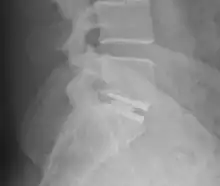

An interbody fusion cage (colloquially known as a "spine cage") is a prosthesis used in spinal fusion procedures to maintain foraminal height and decompression. They are cylindrical or square-shaped devices, and usually threaded. There are several varieties: the Harms cage, Ray cage, Pyramesh cage, InterFix cage, and lordotic LT cage, all of which are made from titanium; the Brantigan cage, made from carbon fibre; and the Cortical Bone Dowel, which is cut from allograft femur. The cages can be packed with autologous bone material in order to promote arthrodesis.[1] Such implants are inserted when the space between the spinal discs is distracted, such that the implant, when threaded, is compressed like a screw. Unthreaded implants, such as the Harms and Pyramesh cages have teeth along both surfaces that bite into the end plates.[1]
Technology: expansion vs. static devices Expandable implant devices are at the forefront of technology in this field, with cages that expand in place for optimal end-plate-to-endplate fit and correction of lordosis. There are several technologies for cage expansion; FLXfit by Expanding Orthopedics offers a unique and patented 3D articulation and lordotic expansion, Staxx by Spinewave stacks plates as risers, Varilift by Wenzel - uses a screw device for enlargement and AccuLIF by CoAlign, which has a unique locking hydraulic solution for precise expansion. FlareHawk by Integrity Implants uses stent-like technology, expanding in width, height, and lordosis.
Once placed, the cages resist flexion and extension of the spine, and axial forces across the ventral and middle columns.[1]
References
- 1 2 3 Gerald E. Rodts Jr; Praveen V. Mummaneni; Regis W. Haid Jr; Kevin T. Foley (2005). "Ventral and Lateral Thoracis and Lumbar Fixation Techniques". In Edward C. Benzel (ed.). Spine surgery: techniques, complication, avoidance, and management. Vol. 2 (2nd ed.). Gulf Professional Publishing. ISBN 978-9997639431.
Further reading
- Paul C. McAfee (1999). "Current Concepts Review — Interbody Fusion Cages in Reconstructive Operations on the Spine". The Journal of Bone and Joint Surgery. American Volume. The Journal of Bone and Joint Surgery, Inc. 81 (6): 859–880. doi:10.2106/00004623-199906000-00014. PMID 10391552.
- Thomas A. Zdeblick; Alexander J. Ghanayem; Andrew J. Rapoff; Carol Swain; Tim Bassett; Mary E. Cooke; Mark Markel (1988-04-01). "Cervical Interbody Fusion Cages: An Animal Model With and Without Bone Morphogenetic Protein". Spine. Lippincott-Raven. 23 (7): 758–765. doi:10.1097/00007632-199804010-00002. PMID 9563105. S2CID 24476957.
- Branko Prpa; Melvin D. Whitfield; Isador H. Lieberman (2005). "Lumbar Interbody Cages". In Edward C. Benzel (ed.). Spine surgery: techniques, complication, avoidance, and management. Vol. 2 (2nd ed.). Gulf Professional Publishing. pp. 489 et seq. ISBN 978-9997639431.
- Robert P. Melcher; Michael Ruf; Jürgen Harms (2005). "Harms Cage". In Daniel H. Kim; Alexander R. Vaccaro; Richard G. Fessler (eds.). Spinal instrumentation: surgical techniques. Thieme. pp. 738 et seq. ISBN 978-1-58890-375-4.
- Frank Kandziora; Robert Pflugmacher; Jan Schäfer; Christian Born; Georg Duda; Norbert P. Haas; Thomas Mittlmeier (2001-09-01). "Biomechanical Comparison of Cervical Spine Interbody Fusion Cages". Spine. Lippincott Williams & Wilkins. 26 (17): 1850–1857. doi:10.1097/00007632-200109010-00007. PMID 11568693. S2CID 35417146.
- Michael Ruf; Dieter Stoltze; Harry R. Merk; Michael Ames; Jürgen Harms (2007-04-20). "Treatment of Vertebral Osteomyelitis by Radical Debridement and Stabilization Using Titanium Mesh Cages". Spine. Lippincott Williams & Wilkins. 32 (9): E275–E280. doi:10.1097/01.brs.0000261034.83395.7f. PMID 17450059.
- Sasidhar Vadapalli; Matt Robon; Ashok Biyani; Koichi Sairyo; Ashutosh Khandha; Vijay K. Goel (2006-09-01). "Effect of Lumbar Interbody Cage Geometry on Construct Stability: A Cadaveric Study". Spine. Lippincott Williams & Wilkins. 31 (19): 2189–2194. doi:10.1097/01.brs.0000232720.23748.ce. PMID 16946652. S2CID 19511678.
- Stephen T. Onesti; Ely Ashkenazi (January 2008). "The Ray Threaded Fusion Cage for Posterior Lumbar Interbody Fusion". Neurosurgery. Congress of Neurological Surgeons. 42 (1): 200–205. doi:10.1097/00006123-199801000-00046. PMID 9442526.
- Kenneth M. C. Cheung; John C.Y. Leong (2004). "Spinal Instrumentation Overview in Lumbar Degenerative Disorders: Cages". In Harry N. Herkowitz; Gordon R Bell (eds.). The lumbar spine (3rd ed.). Lippincott Williams & Wilkins. pp. 286 et seq. ISBN 978-0-7817-4297-9.
- Vijay K. Goel; Manohar M. Panjabi; Huroshi Kuroki; Setti S. Rengachary; D. McGowan; N. Ebraheim (2004). "Spinal Instrumentation". In Harry N. Herkowitz; Gordon R Bell (eds.). The lumbar spine (3rd ed.). Lippincott Williams & Wilkins. pp. 59 et seq. ISBN 978-0-7817-4297-9.
- Darrel S. Brodke; Jeffrey C. Dick; David N. Kunz; Ronald McCabe; Thomas A. Zdeblick (1997-01-01). "Posterior Lumbar Interbody Fusion: A Biomechanical Comparison, Including a New Threaded Cage". Spine. Lippincott-Raven. 22 (1): 26–31. doi:10.1097/00007632-199701010-00005. PMID 9122778. S2CID 21009248.
- J. W. Brantigan; A. D. Steffee; J. M. Geiger (June 1991). "A carbon fiber implant to aid interbody lumbar fusion. Mechanical testing". Spine. Lippincott-Raven. 16 (6S): S277–S282. doi:10.1097/00007632-199106001-00020. PMID 1862425.
- J. W. Brantigan; A. D. Steffee (1993-10-15). "A carbon fiber implant to aid interbody lumbar fusion. Two-year clinical results in the first 26 patients". Spine. Lippincott-Raven. 18 (14): 2106–2107. doi:10.1097/00007632-199310001-00030. PMID 8272967.